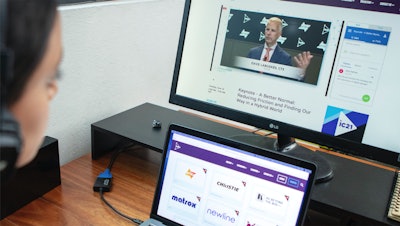
Annette Sandler is the content director at the Audiovisual and Integrated Experience Association (AVIXA). The Virginia-based association produces a live professional audiovisual show, dubbed InfoComm, each June in Las Vegas or Orlando, which drew over 44,000 attendees last year.
With so many large events finding themselves suddenly going virtual, there is a lot to figure out, but also many valuable lessons being learned that can help others in a similar situation.
 Annette SandlerPhoto: Courtesy of AVIXA
Annette SandlerPhoto: Courtesy of AVIXA
As it goes in 2020, though, this year looked much different. The InfoComm management team made the difficult but inevitable decision to cancel the in-person 2020 event about two months before it was scheduled to take place due to COVID-19. However, the AVIXA team was determined to gather the industry together for a virtual version of the event. That determination led to InfoComm 2020 Connected, held June 16-18, which virtually brought together global AV professionals for product demonstrations, networking, education sessions, and keynote presentations.
In planning that event, our team at AVIXA learned several important lessons to share with the larger events industry on taking a very large event virtual. Here are our biggest lessons learned.
Clear communication is just as important in a virtual space as it is in a convention hall.
Do not assume that because everyone is using Zoom and similar platforms all day long now that they will immediately understand how to use your virtual event platform. The willingness to learn how your specific platform works may be lower than you think due to “Zoom fatigue.”
 To reduce any room for confusion or chaos, InfoComm event organizers ensured guests were familiar with the virtual event platform and knew where to find all speaker sessions to tune into.Photo: Courtesy of AVIXA
To reduce any room for confusion or chaos, InfoComm event organizers ensured guests were familiar with the virtual event platform and knew where to find all speaker sessions to tune into.Photo: Courtesy of AVIXA
People need to network.
With the social isolation created by the pandemic, our audiences need human interaction. Those informal connections made at receptions and unplanned exhibit hall conversations are also an important driver of value at events, so provide opportunities to intentionally connect.
For InfoComm Connected, we hosted an AV trivia night that allowed people to socialize with smaller groups by forming teams. A shared activity gets people out of their shells and talking in the same way food and drinks might in a real-life reception. Our happy hour events started in one large virtual room and then randomly sorted people into smaller breakout rooms to meet new people. To make sure the conversation flows, suggest topics for them to discuss before sending them to the breakouts. Tip: To encourage attendee engagement, add features like a Q&A box that allows your guests to interact with speakers.Photo: Courtesy of AVIXA
Tip: To encourage attendee engagement, add features like a Q&A box that allows your guests to interact with speakers.Photo: Courtesy of AVIXA
A chat function within the event platform allowed attendees to chat with each other during learning sessions. Participants also had the option to “upvote” questions being submitted to the speakers in the Q&A box. Another advantage of going virtual, these digital solutions for attendee participation may provide more introverted attendees with a less daunting avenue to engage than approaching a mic at an in-person session.
At the end of the day, connecting buyers and sellers is the most important function of a trade show. To facilitate that connection, we incorporated manufacturer presentations into the agenda with “tech lightning rounds” grouped by product category so attendees could compare options.
Virtual events provide new opportunities to use data strategically.
Going virtual is an enormous opportunity to collect data and learn new things about attendees. In the same way digital marketing revealed new insights into segmenting and targeting customers because it gave us data we never had before, virtual events give us more data on attendees’ behavior.
Now you know exactly when people left a session, and you may have a better sense of how long those sessions really should be moving forward. You will also know who met with whom, which could guide which networking events need to be developed. With audience questions conveniently captured in the chat box, there is a new well of information on what attendees are interested in for future session development. All this data also leads to better ROI for exhibitors; digital footprints provide more information on the quality of a lead than simply scanning someone who pops into a booth for a few moments.
Planning a virtual event is challenging and requires learning many new things quickly. But it is also an opportunity to create even better events in the future—whether they’re in person, virtual, or a mix of both.



















